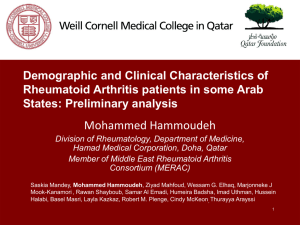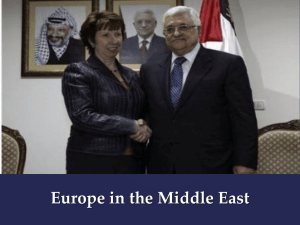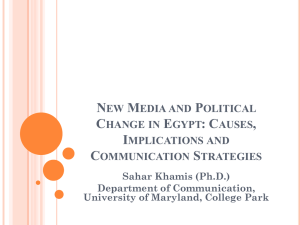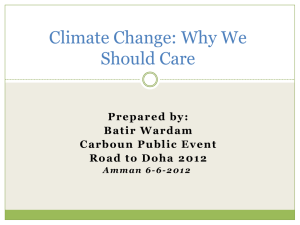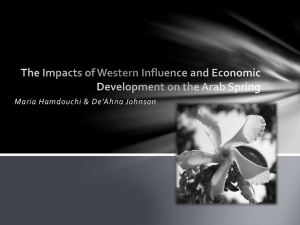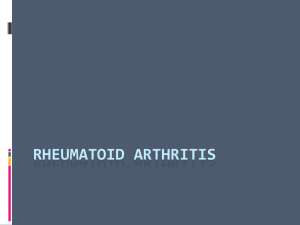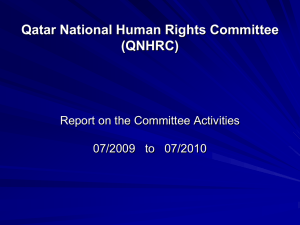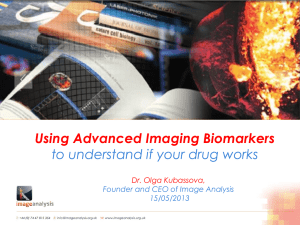MERAC - Weill Cornell Medical College in Qatar
advertisement
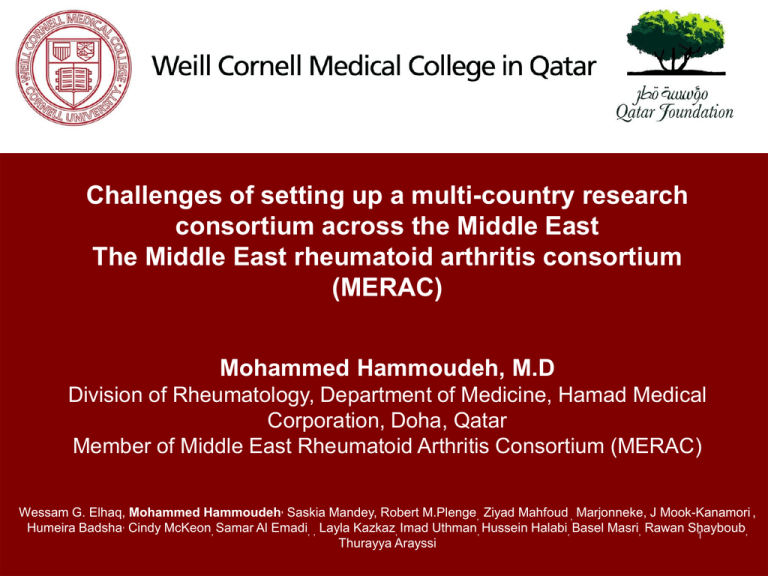
Challenges of setting up a multi-country research consortium across the Middle East The Middle East rheumatoid arthritis consortium (MERAC) Mohammed Hammoudeh, M.D Division of Rheumatology, Department of Medicine, Hamad Medical Corporation, Doha, Qatar Member of Middle East Rheumatoid Arthritis Consortium (MERAC) Wessam G. Elhaq, Mohammed Hammoudeh, Saskia Mandey, Robert M.Plenge, Ziyad Mahfoud , Marjonneke, J Mook-Kanamori , Humeira Badsha, Cindy McKeon, Samar Al Emadi, , Layla Kazkaz, Imad Uthman, Hussein Halabi, Basel Masri, Rawan Shayboub, 1 Thurayya Arayssi Disclaimer Introduction As faculty of Weill Cornell Medical College in Qatar we are committed to providing transparency for any and all external relationships prior to giving an academic presentation. Mohammed Hammoudeh M.D. I DO NOT have a financial interest in commercial products or service. The Middle East Rheumatoid Arthritis Consortium (MERAC)TEAM Members Introduction Research Productivity Requirements Individual, Institutional, and Leadership Characteristics That Facilitate Research Productivity Introduction Research in the Arab Countries • Introduction Little is known: There is no pan-national monitor that could prepare quantitative and qualitative research indices for the Arab region and guarantee the credibility of data produced. • Funding is low: The amounts spent by Arab countries on research and development is little. • Infrastructure is weak :Constraints on scientific research in Arab countries are not limited to the absence or weakness of institutional structures or their lack of staff. They also include the weakness of relevant administrative arrangements and legal frameworks • We cannot work together: Joint research projects among Arab scientific research institutions working in similar fields remain extremely rare even within the same country Number of articles published in the Arab world Introduction Pub/mill USA UK Canada France Lebano n Kuwait Qatar 1129 3347 3759 1805 347 267 226 Example of Research Funding in Arab Countries Introduction As shown, the government expenditure on research in Arab region is 10-30% as compared to that spent in developed countries Our Goal Introduction “Create a network of outstanding collaborators to target the health needs of patients with inflammatory Rheumatic Diseases in the Middle East” Why Rheumatoid Arthritis ? Introduction • Heritability for RA has been estimated to be between 53% and 65% • > 50 genetic variants have been identified by means of genomewide(GWAS) association studies to be associated with RA in North American and European populations • Little is known about the risk alleles contributing to RA among the patients of Arab ancestry in the Middle East The Middle East – RA practice studies Introduction Author (yr) Country #Patient %RF+ HLA %MTX % Biol. Kazkaz (2007) Syria 156 62.9 +SE 74 Badsha (2007) UAE 47 73 - 29 5 Baddoura (2006) Leb 298 69.5 - - - Khalil (2006) Leb 97 - - 52 - Al Saeed (2006) Kuwait 47 74.4 DRB1* 04 - - Al Swailem (2006) SA 70 90 DRB1* 04 Facilitating Factors QNRF vision Introduction • Established in 2006, QNRF as the sole research funding agency in Qatar seeks to build national human potential by funding research and other activities to accelerate development of opportunities for education and training in basic and applied research related to needs in Qatar. 2010 SSREP 2006 UREP Existing program New program 2010 2007 YSREP NPRP SSREP: UREP: YSREP: NPRP: NPRP-EP: DFP: 2010 NPRPEP 2011 DFP Secondary School Research Experience Program Undergraduate Research Experience Program Young Scientists Research Experience Program National Priorities Research Program NPRP Exceptional Proposals Distinguished Fellowship Program Adapted from QNRF presentation, Courtesy of Dr. K. Machaca. Opportunity: WCMC-Q cores Introduction Basic Sciences Clinical Research Genomics • IRB Microscopy • Clinical Research Support Proteomics • Biostatistics Core Vivarium Grant Management Middle East Rheumatoid Arthritis Consortium(MERAC) Introduction Qatar UAE • 6 Clinical and research centers • 8 regional rheumatologists • International collaborators • Develop DNA and clinical databank • Study Rheumatic Diseases (RA) in the Middle East • Submit for funding from regional and international sources Jordan International Collaborators WCMCQ Syria Lebanon KSA First Study : Genetic studies of Rheumatoid Arthritis in some Arab States (GRAAS) Introduction • Goals • Methodology( Network establishing) • Research plan & study timeline • Execution • Challenges & Strategies • Conclusions Goals Introduction • Setting up the infrastructure to enroll and collect at least 2000 rheumatoid arthritis patients of Arab ancestry (cases) and 2000 (controls) from 5 Rheumatology centers across 5 Arab Nations • Investigate the role of rheumatoid arthritis risk alleles in patients of Arab ancestry • Study the demographic and clinical characteristics of these patients • Ensure High quality verifiable data Methodology 1-Planning : Introduction • Selection of qualified sites & collaborators4 • research plan • study timeline 2- Funding 3- IRB Approvals 4-Infrastructure • Recruiting team members • Develop a study manual & training materials • Communication 5-Patient Recruitment 6- Data collection • Web-based data collection • Blood collection & DNA extraction 7-Shipment 8-Data analysis 9- Study monitoring 10- Publication Introduction Challenges Challenges -1. Planning Introduction Selecting qualified sites & collaborators: • • • • Prior research experience Motivation and commitment Large patient base Resources: Freezers, computers…..etc. Developing the research plan: • • Creating initial drafts Reaching consensus for final draft Challenges-1.Planning Introduction Developing a Study Timeline: Be generous when working out time frames • Defining the research objectives • Define the actual stages of your research • Set a realistic timeline • Resolving external constraints & meeting deadlines Study timeline MERAC Study Timeline 2011 - 2015 Introduction 2011 Activity Mar Planning Approvals Infrastructure Enrolment Shipment DNA extration Data analysis Publications Completion 2012 Sep Mar 2013 Oct Mar 2014 Oct Mar Oct 2015 Mar Challenges-2.Funding Introduction • Funding resources • Awareness of deadlines • Be educated about requirements • Appropriately detailed budget based on the market prices Challenges- 3.IRB Approvals Introduction • Ethical awareness of human subject research • Be aware of IRB approval processes in the different counties • Monitor IRB status & renewals at the multiple centers Challenges - 4. Selecting team members Introduction Human Resources: • Finding a previously trained research associate(RA) was difficult • Standardization of staff practice across the different sites • Availability of specialists & making RA attractive to young physicians Challenges- 5.Study manual & training material Introduction Development of password protected webpage that has study manual, training material and video • SOP & forms • ICF video Challenges - 6. Patient recruitment Introduction Total number of patients to be recruited per year with equal number of controls To increase the number of recruited subjects : -Increase the population awareness( brochures & flyers) - Consider a Control Drive: to enroll a greater number of controls totally free from any underlying auto-immune disease & who are not relatives of the cases Challenges- 7. Data collection(clinical data) Introduction Web-based data collection( electronic data entry) • Creation of an electronic survey( questionnaire) to enter the full data of each subject during the enrolment session • Secure internet connection availability in all the collaborating sites • Carry out day-to-day communication with the other sites • Back-up plans in facing web glitches • Collect , monitor, & clean data from all the collaborating centers • Getting on board the expertise in biostatistics, computer programming & data management Challenges - 7. Data collection( blood data) Introduction Blood collection & DNA extraction • Lab space availability • Equipment availability : Freezers, fridges, centrifuge…..etc. • Materials & lab supplies availability : DNA extraction Kits, tubes, pipettes…etc. • Securing of the blood samples Challenges - 8. Shipment • Introduction Finding the appropriate courier • Securing the availability of dry ice needed for shipment • Getting the legalized customs documents in each site • Shipment cost Challenges- 9. Monitoring Introduction Study monitoring: • Site visits • Audit reports Finance monitoring: • Budget monitoring • Reimbursement processes • Budget re-allocation Data monitoring: • Monitoring of the data quality & center performance • Ensuring high data quality & inter-site consistency : 1. Standardization 2. Training 3. Assessment 4. Retraining Achievements Introduction 1. A tight, well established multicenter research network with all the constituents to perform ,monitor , publish reliable results & outcomes 2. Productivity after one year • One publication • One poster presentation • Two oral presentations Future Plans Introduction To set up a Scientific advisory Board (SAB) & executive committee for MERAC monitoring the consortium by: • Review of applications for collaboration and requests for sharing material from the investigators outside the consortium • Review of the publications before submission • Advise the consortium in new research area The Ten Commandments for Researchers • Fully understand the conditions Introduction of the country and society. Commit to involving young researchers in research projects, and also to training them • Focus on beneficial scientific research, and do not become preoccupied with trivial matters. Write highly competitive research proposals, and submit them in requests for support from international institutions. Publish in respected international journals Persistently pursue self-education Believe in and be proud of the scientific research profession. • Carefully select research projects and methodologies • improve communication skills in foreign languages • Build local and regional/international networks of cooperation. http://www.mbrfoundation.ae/English/pages/AKR2009.aspx, accessed March 24 2011 Acknowledgements Introduction Weill Cornell Medical College-Qatar Saskia Mandey Ziyad Mahfoud Wessam G. Elhaq Marjonneke Mook-Kanamori Cindy McKeon Rawan Shayboub Thurayya Arayssi King Faisal Specialist Hospital & Research center, Jeddah, Kingdom of Saudi Arabia Hussein Halabi Jordan Hospital, Amman, Jordan Basel Masri Hamad Medical Corporation, Doha, Qatar Tishreen Hospital, Damascus, Syria Samar Al Emadi Layla Kazkaz Al Biraa Arthritis and Bone Clinic, Dubai, UAE Humeirah Badsha American University of Beirut, Lebanon Imad Uthman Broad Institute, Cambridge, MA, USA Robert Plenge Introduction Thank You
